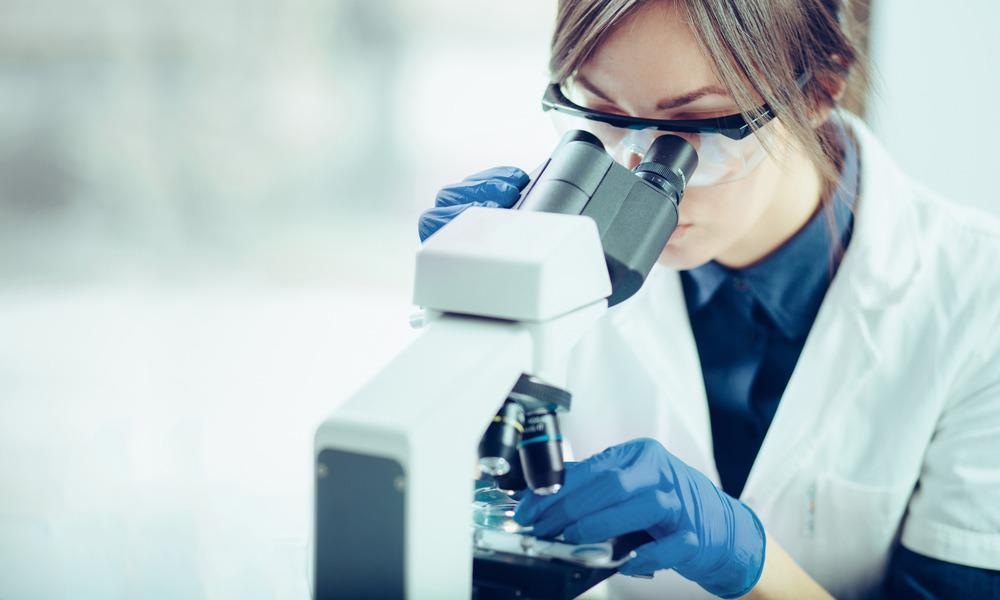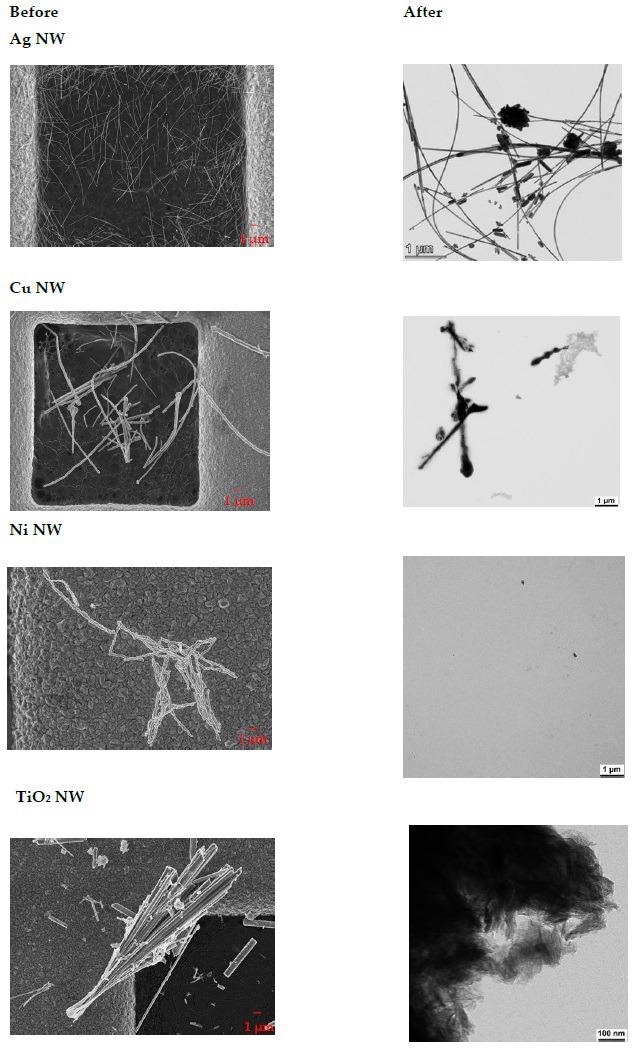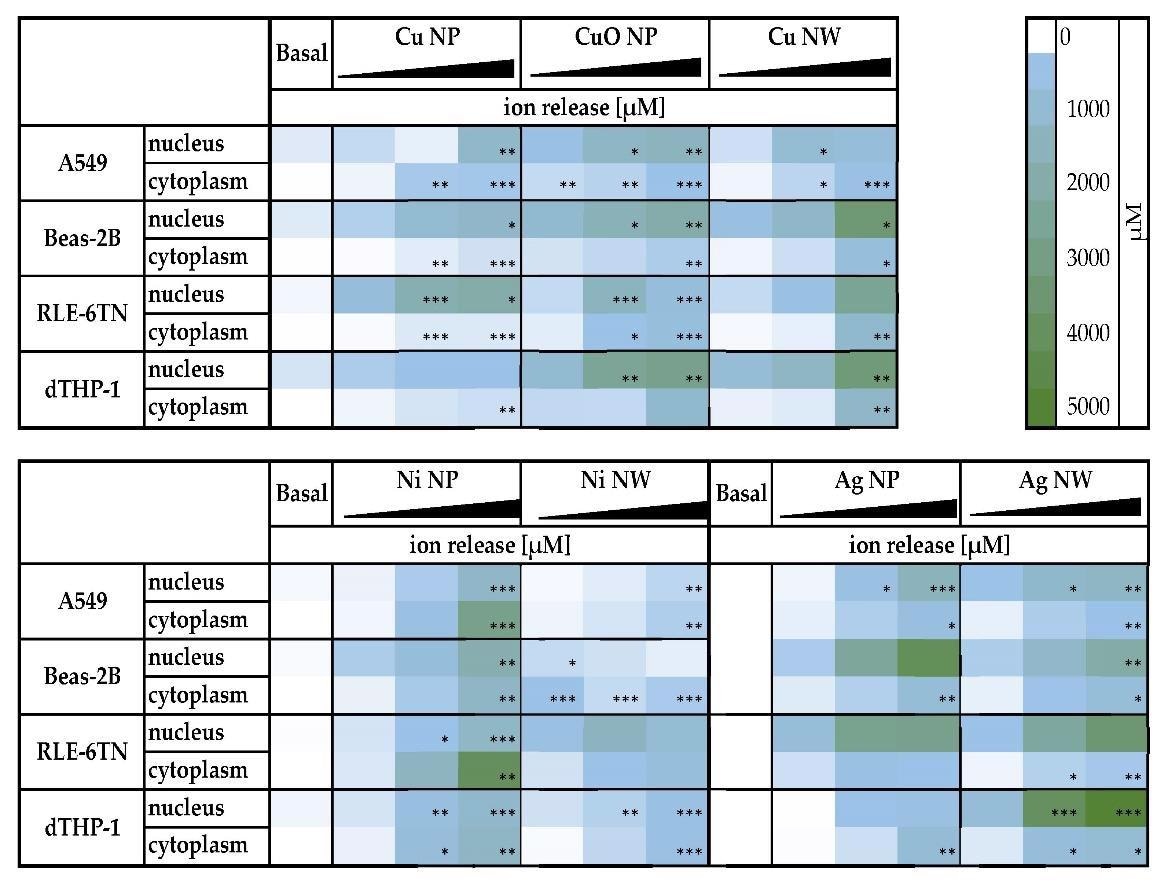Novel findings were reported in a study published in the journal Nanomaterials regarding several metals and their reactivity, solubility, and cytotoxicity.

Study: Comparison of Metal-Based Nanoparticles and Nanowires: Solubility, Reactivity, Bioavailability and Cellular Toxicity. Image Credit: Likoper/Shutterstock.com
Nanoparticles in Consumer Products
Engineered metal-based nanoparticles have been used in a wide range of consumer products, including textiles, electronic parts, and pharmaceuticals. Aside from metal-based nanomaterials, fibrous substances (nanowires) are growing in popularity, for example, as transparent electrical contacts on displays.

EM images of NP and NW before and after treatment in the flow-through cells with phagolysosomal simulant fluid (PSF).© Wall, J., et al. (2022)
As a result, a diverse range of nanoparticles are available, each with unique physicochemical characteristics such as size, form, and surface composition.
Inhalation is by far the most prominent route of nanoparticle exposure and absorption, particularly at work. Nanomaterials, factors such as the size and form, can attain various areas of the lung, such as the alveolar surface.
However, due to the wide variety of these nanoparticles and their wide range of physicochemical characteristics, a general toxicity evaluation appears difficult. As a result, a clustering approach based on several physicochemical characteristics appears promising for analysis.
Conventional Method for Detecting Cytotoxicity
The production of reactive oxygen species (ROS) and therefore oxidative stress has already been identified as a significant method resulting to genotoxicity and cytotoxicity in metal-based nanoparticles. As a result, two scenarios are possible.
First, the subcellular update of metal ions has seemed to be crucial. That a so 'Trojan horse type' method describes endocytotic absorption of metal-based materials followed by lysosomal dissolving, leading to high metal ion concentrations inside the cells, which has been observed for Copper, Silver and Nickel based nanoparticles.
Second, owing to its unique surface reactions, the components themselves can catalyze the conversion of ROS. Recent research has shown that various metal-based nanoparticles have a high oxidative reaction.

Impact of nanomaterials on the ATP content of A549, Beas-2B, RLE-6TN, and dTHP-1 cells after incubation with five different doses of the nanomaterials. The ATP content of incubated samples was normalized to an untreated control. Significantly different from negative controls: * p ≤ 0.05, ** p ≤ 0.01, *** p ≤ 0.001 (ANOVA-Dunnet’s t-test). © Wall, J., et al. (2022)
Metal Based Cytotoxicity
Whereas the toxic effects of metal-based nanoparticles (NP) has been studied extensively, little is identified regarding metal-based fibrous materials, also referred to as nanowires (NWs).
The physical and chemical properties of particle and fibrous nanoparticles based on Cu, Ni, Ag, TiO2 and CeO2 NP have been categorized and evaluated in terms of abiotic metal cations discharge in different highly bioavailable media and acellular reactions in the current study.
It illustrates that metal-based fibrous nanoparticles are absorbed into cells relying on the type of cell. Endosomal and lysosomal vesicular uptake of Ag NW has been proposed. Nevertheless, the questions as to whether their fibrous framework contributes to toxicity as well as whether metals are also released intracellularly remain unanswered.
Research Process
Particulate and fibrous metal-based nanoparticles were thoroughly characterized in terms of their physical and chemical properties. Aside from nanoparticles known to possibly release toxic metals (Cu, CuO, Ni, and Ag), non-reactive components with particulate and fibrous morphologies (CeO2 and TiO2) also were included.
The team compared those in terms of abiotic metal cations release in various biologically relevant media as well as acellular reactivity. Following that, four distinct cell lines were used to make comparisons cytotoxicity and intracellular metal cations discharge in the nucleus and cytoplasm.
Because inhalation is likely as being the most dangerous source of exposure, two induced lung cell lines representing various areas of the respiratory system were picked: A549 cell lines (alveolar area) and BEAS-2B cell lines (bronchial area) (normal human bronchial epithelium obtained from non-cancerous individuals).
Results
The primary diameter of Cu NP was the largest, measuring 55.2 nm. All components had the same order of magnitude of fiber diameter. The dispersion of Ni NPs had been very polydisperse, and this particulate species did tend to agglomerate.
With the case of TiO2 NP, the stored dose ranged from 22% to 90%. When compared to untreated Ag NW, particles in the air morphologies were observed, portraying the thermodynamically stable state.
Due to a high solubilization of Cu NW in PSF, a smaller group of Cu NW with newly formed structural components was found on TEM grids. Sulfidation happened to coincide with an increase in polymorphism from continuous strands towards a greater number of small particulate structures

Intracellular distribution in cytoplasm and nucleus of A549, Beas-2B, RLE-6TN and cells after incubation with three doses metal-based nanomaterials. Significantly different from basal concentration: * p ≤ 0.05, ** p ≤ 0.01, *** p ≤ 0.001 (ANOVA-Dunnet’s t-test). © Wall, J., et al. (2022)
Cytotoxic Characteristics
All materials that were dissolvable in lysosomal fluid exhibited a dose-dependent cytotoxic activity in all cell cultures tested. Furthermore, a dose-dependent loss of cell validity was observed after culturing with the Ag-based materials, despite the absence of ion release in the lysosomal liquid for this substance.
The most sensitive response to all lysosomal-soluble nanoparticles was observed in dTHP-1 cells, a cell culture prototype with macrophage-like characteristics.
Apart from Cu-based components, the implementation of NW did result in less prominent cellular toxicity when trying to compare NP and NW of same material at the same concentration levels. Even at the greatest applied dose of 100 g/mL, no reduction in viability was noticed for the insoluble materials, TiO2 NP and CeO2 NP.
Pattern of Metals Characteristics and its Advantage
The cytotoxic activity seemed to be caused by intracellular disintegrated metal ions accompanied by metal ion overload, rather than by nanomaterial-cell conversations, which is relevant to the proposed Trojan-horse method.
An intriguing exception has been observed in the case of Ag-based components, where acellular dissolution did not foresee cellular toxicity or bio-availability, indicating safety of use.
This could be due to the formation of secondary particles produced after nanoparticle dissolution, that also likely hasten in acellular processes and thus remain impossible to detect in the sample extract, but which may contribute to the dissolved and thus absorbable fraction in the cell. Differences in toxic effects and bioavailability between cell lines were metal-dependent, without any common pattern across metals.
Continue reading: Analyzing the Antiviral Activity of Graphene Oxide Against COVID-19 and Other Viral Infections.
Reference
Wall, J., et al. (2022) Comparison of Metal-Based Nanoparticles and Nanowires: Solubility, Reactivity, Bioavailability and Cellular Toxicity. Nanomaterials 2022, 12(1), 147. Available at: https://www.mdpi.com/2079-4991/12/1/147
Disclaimer: The views expressed here are those of the author expressed in their private capacity and do not necessarily represent the views of AZoM.com Limited T/A AZoNetwork the owner and operator of this website. This disclaimer forms part of the Terms and conditions of use of this website.